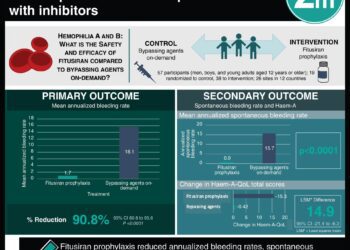Patient Basics: Hemophilia
Originally published by Harvard Health.
What Is It?
Hemophilia is an inherited disorder. It prevents blood from clotting properly. People with hemophilia bleed longer than usual. This bleeding can range from mild to severe. In severe cases, people with hemophilia can bleed to death.
Because of the way in which hemophilia is inherited, it almost exclusively affects men. Women can get it, but it is very rare.
Clotting is the process in which the blood thickens or congeals. This prevents a cut or other injury from bleeding endlessly.
Clotting factors are substances in the blood that help the blood to clot. People with hemophilia do not have enough clotting factors.
Blood clotting involves two sets of factors. One set works with specialized blood cells called platelets. Platelets play a central role in blood clotting. The other set of factors involves the coagulation system. Coagulation is a coordinated series of chemical reactions that clots and stops the bleeding.
The main clotting factors involved in hemophilia are Factor VIII, Factor IX and Factor XI.
Types of hemophilia:
- Hemophilia A is the most common type of hemophilia. People with hemophilia A do not have enough clotting factor VIII. Most people with hemophilia A have severe disease.
- Hemophilia B is also known as Christmas disease. It is caused by a deficiency in clotting factor IX. It can be mild, moderate or severe.
- Hemophilia C is also called factor XI deficiency. It is uncommon in the United States. Hemophilia C is caused by a deficiency in clotting factor XI. It is inherited differently than Hemophilia A or B. As a result, it can be passed to both male and female children.
Symptoms
People with hemophilia may bleed anywhere in the body. However, they seldom bleed significantly from small cuts or puncture wounds.
Rather, hemophiliacs bleed more than other people do from significant injuries, trauma or surgery. How badly and how often people bleed directly relates to how much clotting factor they have.
People with hemophilia may experience:
- Bleeding into the joints. The joints are the most common place for bleeding to occur. The ankle, knee or elbow joints are most commonly affected. The affected joint becomes warm, painful and swollen. The person is not able to move the joint as freely as before. This can happen after an injury or without any cause.
- Bleeding into muscle.
- Bleeding into the esophagus, stomach or intestine.
- Bleeding into the urine.
- Bleeding from the nose and gums.
- Heavy menstrual bleeding (in women).
A less common but more serious complication is bleeding into the brain. Symptoms include sudden nausea, headache and decreased mental awareness.
Symptoms of factor XI deficiency usually appear only in people who inherit the disease from both parents. Symptoms can include:
- Prolonged and/or excessive bleeding after cuts, surgery or dental extractions
- Nosebleeds
- Blood in the urine
- Abnormally heavy or prolonged menstrual bleeding
In hemophilia C, bleeding without any cause is rare.
Diagnosis
People with severe hemophilia often develop bleeding problems within the first two years of life. Many infants are diagnosed when they have prolonged bleeding after circumcision. Others are diagnosed in childhood. They may develop excessive bruising and bleeding into joints after typical childhood injuries.
People with mild hemophilia may not be diagnosed for decades. Diagnosis may only occur after they experience abnormal bleeding after trauma, injury or surgery.
If your doctor suspects that you have hemophilia, he or she will ask how often you bleed and how severely. Your doctor will also ask if anyone in your family has a bleeding problem.
Your doctor will examine you. He or she will focus on evidence of past bleeding into the skin, muscles and joints.
A variety of blood tests will show if your blood has a clotting defect. The diagnosis of hemophilia A or B or factor XI deficiency can be confirmed by examining specific clotting factors.
Expected Duration
Hemophilia is a lifelong illness. Symptoms usually can be controlled with proper medical treatment.
Prevention
People with a family history of hemophilia can learn their risks of passing hemophilia to their children. A simple blood test is usually all that is necessary.
People with hemophilia should take steps to avoid injuries, accidents and excessive strain on the joints. This can help to prevent episodes of bleeding. For example:
- An infant with hemophilia should have appropriate padding in his crib or playpen.
- A toddler with hemophilia should be supervised as he learns to walk.
- A school-age child with hemophilia should avoid contact sports and activities that have a high risk of trauma.
People with hemophilia may need a blood transfusion at some point. They should get immunized against hepatitis A and B, diseases that can be carried in blood products.
People with hemophilia must avoid aspirin and other medications that affect blood clotting.
Treatment
Preventive treatment
Clotting factor concentrates help to replace the missing clotting factor in the blood. This can help to decrease how often and how severely you bleed. Clotting factor concentrates are given by injection into a vein.
In the past, people would receive concentrates of clotting factors that had been collected from blood donors. Today, man-made Factor VIII and Factor IX (called recombinant Factor VIII and recombinant Factor IX) are created in vast quantities.
Recombinant hemophilia factors are made in the test tube. They are not extracted from human blood products. So, the risk of contracting transfusion associated virus diseases (such as HIV and hepatitis viruses) is greatly diminished.
Treatment for excessive bleeding
Sometimes excessive bleeding occurs despite the use of recombinant clotting factors. Hospital treatment is necessary when bleeding occurs. The situation is an emergency when it involves the brain, neck, the central nervous system or a vital organ.
Hemophiliacs may require blood transfusions to treat excessive blood loss.
All surgical or invasive procedures should be done in a hospital to properly handle bleeding. Consult your doctor before having dental work.
Some patients develop blockers to the Factors, making them less effective. If this happens, specialized treatments may be required to enable the factors to work again.
When to Call a Professional
Call your doctor if you notice unexplained or severe bruises or a warm, painful joint on your child’s body. If you are an adult and you experience these symptoms, call your doctor.
Professionals trained in both hematology and blood coagulation disorders are best equipped to diagnose and treat hemophilia. People with bleeding disorders should consult with these specialists.
Prognosis
How well you do depends on the type of hemophilia and its severity. Thanks to the development of clotting factor products, most people with hemophilia can look forward to a near-normal life span.
There are three main complications that may develop in people with hemophilia:
- Joint destruction – Multiple episodes of bleeding into joints can result in severe joint damage.
- Blood-borne infection – Blood testing and purification techniques have improved markedly over the years. It is now exceedingly rare for hepatitis or HIV infections to be transmitted through blood products.
- Development of inhibitor antibodies – People who are treated with clotting factors can develop inhibitor antibodies. These are proteins that decrease the effectiveness of the clotting treatment. When this occurs, treatment can become complicated and expensive.
Additional Info
National Heart, Lung, and Blood Institute (NHLBI)
P.O. Box 30105
Bethesda, MD 20824-0105
Phone: 301-592-8573
TTY: 240-629-3255
Fax: 240-629-3246








